

MORTIKA
The word 'mórtis' in Greek underworld slang refers to a person
who is both tough and elegant, as it were the cool bearer of knife and
suit, a counterpart to the 'apache' of Paris. Mórtika simply
means songs about male 'mórtes' and female 'mórtisses'. (See
also glossary below). This CD holds a collection of urban songs and
instrumentals centred on this theme, recorded commercially between 1927
and 1946 by Greek musicians in Greece, Germany and the USA. (Track
16, undateable, and track 21, privately recorded in 2000, are
exceptions.) All, in conventional terminology, might be considered
as belonging to the 'rembetica' genre, but we who have compiled and
produced this record would rather see them emancipated from the
straightjacket of genre categorisation. Apart from the intrinsic,
moving musical quality of the performances, this compilation is
distinguished by the rarity, and often excellent condition of the
originals, and by the quality of Ted Kendall's remastering.
Listening through Mórtika, you will make the
acquaintance of some of the central figures of the period, both
instrumentalists, singers and songwriters, and become familiar with
some of their variety of vocal styles and techniques, their idiomatic
use of various plucked, hammered and bowed string instruments, and the
accordion, and also with their song lyrics, which treat of typical
'underworld' themes such as drugs, love, theft, murder, prison, and
having a good time. All this music is associated, one way or another,
with subcultures of outsiders, whether at home or in imposed or
self-chosen exile, and whether they represent the urban musical culture
of Asia Minor and Istanbul/Constantinople, the local tradition of
Piraeus subcultural music, or the Greek musical culture of the
Greek-American population.
You will hear the pioneer Greek-American bouzouki player Ioánnis
Halikiás (aka Jack Gregory), the pioneer of Piraeus
rembetica Márkos Vamvakáris, the great singers of
Asia Minor origin Ríta Abadzí and Andónis
Dalgás, the singers Maríka Papagíka, Stellákis
Perpiniádhis and Kóstas Roúkounas, and
two of the handful of recorded guitar-playing Greek songsters of the
period, Yiórgios Katsarós and 'Kostís',
based in the USA and Athens respectively. Furthermore, you will hear a
very early recording by Dhimítris Góngos
'Bayiandéras'. Here is one of the only two known recordings
by the bouzouki player known as Manétas, cited by both Márkos
Vamvakáris and Stelios Keromítis as one of
the seminal figures of the Piraeus bouzouki of the 1920s and
responsible for what became the standard DAD tuning of the three-course
bouzouki. The major recording artist on the accordion of this period, 'Amirális'
Papadzís, is here, and one of the only two known sides
recorded by a little known bouzouki player and singer called Zouridhákis.
The composer S. Gavalás is the featured vocalist on a
virtually unknown, incredibly well preserved recording. On many tracks
you will hear one of the studio eminences of the period, Spýros
Peristéris, playing mandolin, mandola, guitar and bouzouki.
The collection is rounded off by a contemporary recording by musicians
who sing and play as though time stood still, independently of the
whole 'rembetica revival' phenomenon of the past few decades.
These notes, eschewing repetition, hope rather to add new perspectives
to previous writing (see bibliography & discography) on
various aspects of the recorded urban Greek music of this period.
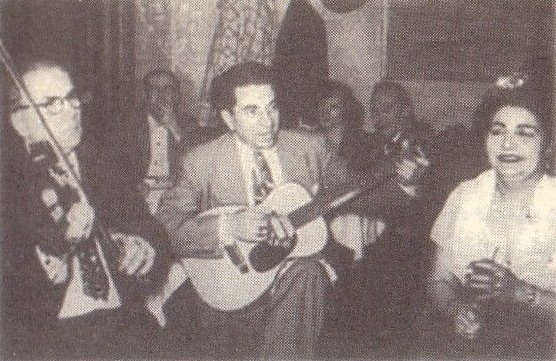
On
recorded music
In 1878, Thomas Edison established the Edison Speaking Phonograph
Company to sell the new machine which he had invented during the
previous year. Before this, printed music, musical instruments, music
lessons, and the opportunity to listen to living musicians in real
time, had been the only musical commodities. The invention of sound
recording created a new commodity, and triggered a novel industry - the
manufacture and sale of petrified sounds. The recording industry -
likewise the owner of the means of production and distribution - has
since then immortalised sounds considered, and often proved, saleable.
That music could be recorded and distributed autonomously by virtually
anyone, was unthinkable until the digital and Internet revolutions
placed the means within the reach of millions.
Thus the obvious but easily overlooked fact that the legacy of
commercially recorded music is no more than a document of the choices
and successes of the recording industry's marketing analyses and value
judgements and not a representative historical document of the music
making of mankind since 1878. Non-commercial field and documentary
recordings represent, likewise, the no less subjective, though often
different, choices of musicologists. Together, these legacies are what
we have. If, for example, a certain kind of music is considered
unsaleable because its public is believed to lack buying power, and
'irrelevant' to ethnomusicologists because it isn't 'true folk music',
then it stands a good chance of not being immortalised on disc.
Early
Greek recordings
Unfortunately the very early Greek recordings have been inaccessible to
this writer, (for one exception see 'guitar' below), which
precludes appraisal of their style and content. Their very existence is
however worthy of brief mention. The first known records of Greek music
were made by tenor Michalis Arachtingi in New York in May 1896,
on the Berliner label. The first recordings from Greece itself
known to this writer were made for documentary purposes on the island
of Lesbos in 1901, by an Austrian researcher (see discography).
The next commercial Greek recordings we know of date from circa 1903;
made in Constantinople, they also appeared in Egypt. Information as to
when the first commercial recordings were made in Greece itself is
unclear. According to Paul Vernon, Odeon may have made large
numbers of recordings in Athens, beginning in 1904, but virtually all
the documentation appears to have been destroyed.
It would appear that the Gramophone Company recorded more than
200 sides in Athens during 1907 and 1909, having previously made Greek
recordings in Egypt. A number of documentary recordings of Greek music
were made in Germany in 1917 by Preussische Phonographische
Kommission. At the time of writing we lack further information on
commercial recordings made in Greece itself before 1952, and there is
sparse documentation on the urban Greek music of the period outside of
the commercial recordings. All this rather 'negative' information
serves to underline how truly difficult it is to delineate the early
history of 'rembética'.
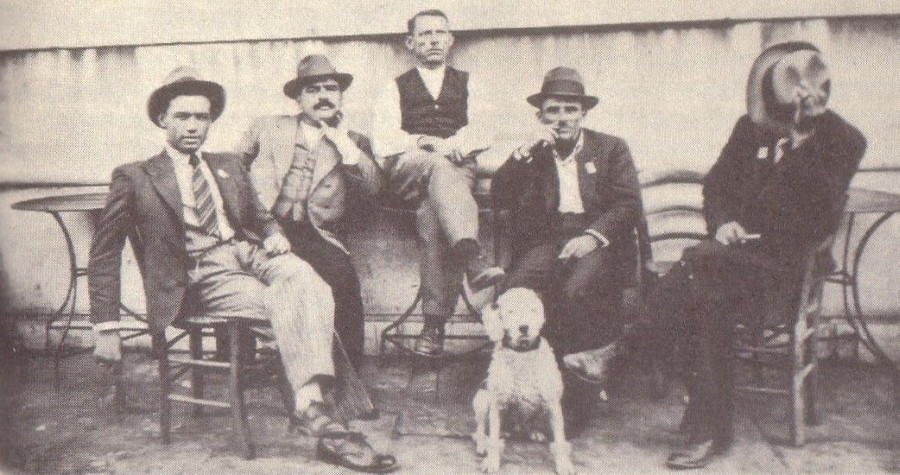
Observations
on rembetica and the genre question
The varieties of music contained in Mórtika have been
known by the blanket term 'rembética' (Greek
'ρεμπέτικα') at least since Ilías
Petrópoulos first published his pioneering book 'Rembétika
Tragoúdhia' in 1968. A certain number of songs were indeed
designated as 'rembétiko' on record labels very early on, but
these were pieces of a mildly erotic or demi-mondaine nature, far
removed from what later came to be designated as rembetica. However, in
all forms of art, genres are nearly always after-the-event
constructions of historians, critics and businessmen, in varying
combinations, and this music is no exception. The word 'rembetis' is
the masculine form of one of several Greek argot terms for persons
embodying various kinds of subcultural attitudes and behaviour whether
it be in terms of dress, drug use, fighting, other criminal activity,
or varying kinds of behaviour valued as 'honourable' within the
culture. In its plural adjectival form 'rembetica' thus came to be used
as a blanket term for a variety of musical styles whose only common
denominator is, in the final analysis, that they have been embraced by
a particular Greek revivalist subculture from the 1970s onwards. Many
will immediately associate to the bouzouki as the emblematic instrument
of this 'rembetica'. Mórtika will dispel this inaccurate
and sweeping notion and impart a more varied perspective.
More
history
Much of mainland and island Greece lived under Ottoman domination for
about four centuries. Crete was still under Ottoman rule as late as
1913. Various Italian city-states were also power factors at various
times. The establishment of the geographical boundaries of Greece as we
know it today was not finalised until 1947, and, of course, the Cyprus
question is still not resolved.
The musical consequences of this are probably still not well
understood. We really can't know of any music which can be said to have
survived in pure Greek form through all those centuries - in fact one
might very well ask: what is pure Greek music? Some Greeks might gladly
lynch me for asserting that. Cultures of subjugated groups in other
parts of the world have certainly used the musical language and tools
of their conquerors and rulers, albeit married to original ethnic
elements, as the examples of blues, jazz, much South American music,
and Hindustani classical music, dearly show.
As citizens of the Ottoman Empire, many ethnically Greek musicians were
members of a cosmopolitan profession. Recognition within Ottoman art
music was accorded of merit, not ethnicity, in spite of the Ottoman
millet system of segregation according to religious affiliation.
Movements and migrations within the various previously or currently
Ottoman dominions meant that, for example, musicians who were
ethnically Armenian, Greek, Gypsy, Jewish, Romanian, or Turkish had a
considerable shared repertoire.
Urban musical culture of Asia Minor during the first decades of the
20th century being thus truly cosmopolitan and 'transethnic', the same
musician could record in both Greek and Turkish although 'ethnically'
neither, and be defined as Greek when suitable. Prominent examples, not
represented on this particular CD, are the singer Róza
Eskenázi, born into a Jewish family in Istanbul, who sang in
both Greek and Turkish, her Armenian-born oud player Agápios
Stamboúlis, (see opposite page) and the oud player 'Marko'
Melkon Alemsherian, also of Armenian parentage. Born in Izmir,
Melkon fled to Greece to avoid conscription in the Turkish army, and
emigrated from there to the USA in the early 1920s, where he recorded
songs in Armenian, Greek and Turkish. The resolution of the
Greek-Turkish conflict of the early 1920s, when the territorial limits
of today's Greece were in large part defined, resulted in the
large-scale relocation of populations on the basis of religion, and
many musicians from urban Asia Minor who had previously functioned in
that cosmopolitan culture found themselves in Greece. They were often
highly competent 'learned' musicians who played instruments not
previously identified as typically 'Greek', for example oud, kanun,
santoúri, and kemençe (called lyra in Greek).
This had great significance for the development of the music on this
record.
Thus, which music which today can be called Greek, and what its 'true'
roots are, are complex questions, which will be answered very
differently according to the perspective of the person asked. Extreme
nationalists, keen on purifying Greek music from vile Turkish and/or
Gypsy contamination, may either dismiss oriental modal forms as
unGreek, or claim that they are of Greek origin (Byzantine or ancient
Greek or both). Orientalists such as Alain Daniélou may
assert close relationships with Indian ragas which - only superficially
or coincidentally - share similar or identical scalar material.
The viewpoint held by the compilers of Mortika is that we are simply
presenting some very good music from outside the conventional
mainstream of Greek popular music, played and sung by people who
probably defined themselves as Greeks even if not born in Greece, and
whose musical roots drew nourishment from the soils of the Greek
mainland, the Aegean islands, Crete, Asia Minor, and the USA.

Drug
themes and rembetica
Themes connected with drug use provided the subject matter for a fair
proportion of the songs recorded during this period, and indeed for
many of the songs on this record. Cannabis is the commonest drug
mentioned, though heroin and cocaine also figure, as do wine and
spirits. Common sub-themes are the search for a drug-dealer, the water
pipe, the 'teké' milieu where 'mánges' smoked hash, and
played and listened to baglamás and bouzouki, fights involving
drug users, and the state of abstinence called 'harmania'. Many
but certainly not all of the significant musicians of the period were
drug users, and one famous figure, Anéstis Deliás, died
very young of a heroin overdose, some years after recording a warning
song about hard drugs.
During the Metaxas regime (1936-1941), censorship of this and other
'subversive' kinds of subject matter, and edicts aimed at eradicating
the Asia Minor oriental style of music, were introduced in Greece.
Censorship was very effective from 1937 to 1941, relaxed for a brief
period after the liberation, and was back in full effect by autumn
1946. From that time on, until the PASOK party came to power in 1981,
songs about drugs were simply absent from the 'official' Greek scene as
though they had never existed, though old recordings, and knowledge of
the repertoire, certainly circulated in private circles. Nowadays the
old recordings are freely reissued in Greece.
One might ask: what was the significance of songs on drug themes
in'rembetica'? Neither romanticising nor idealising drug use at the
time they were composed and recorded, they rather told stories of
everyday life, commanding no particular musical frameworks or stylistic
elements that distinguish them from songs on other typical 'rembetica'
themes of the same period. A reasonable view would be that they
asserted and confirmed the role of drugs, and drug-associated rituals,
in defining aspects of sub-cultural group identity. Which can also be
said about some other typical themes of rembetica.
So what, if anything, is specific about drug themes? Drugs offer an
escape into another sphere of feeling, perceiving and relating, a
respite from life's normal toughness. If we consider that this music
evolved mainly among people who shared experiences of exile, of poverty
and deprivation, of life on the outside of 'society', it is perhaps not
too far-fetched to conjecture that drugs were a sort of comforting
maternal substitute, and that the 'high' was, at least in part, a state
reminiscent of the paradise of early maternal care. So the emphasis on
this in the songs might in turn be seen as a covert hymn to the mother.
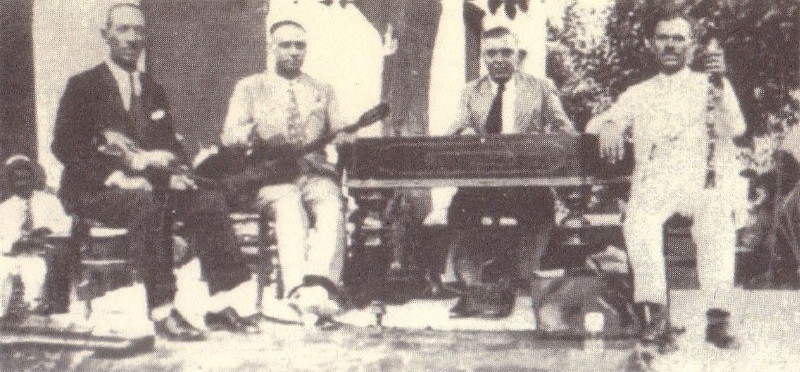
THE
INSTRUMENTS
There are some major traps in studying the history of musical
instruments. The same word may denote quite different instruments, and
the same instrument may be known by etymologically quite distinct
names. An instrument that has wandered in time across national and
cultural boundaries, may be 'appropriated' by nationalist apologists in
any of its host countries. Both European and Oriental instrument-making
traditions flourish side by side in Greece, and not one of the
instruments to be heard on this CD - accordion, baglamas, bouzouki,
cello, guitar, mandola, mandolin, laouto, lyra, tsémbalo,
kombolói, violin - can claim exclusively Greek origin as to both
name and form. In the following we have tried to give some detailed
accounts in a manner hitherto not attempted within the scope of CD
booklet notes.

Baglamas
# 21
The diminutive three single- or double-strung plucked baglamas takes
its name from one of the several sizes of the Turkish long-necked lute
known in Turkey today as the 'saz'. It is, of all the instruments
mentioned here, perhaps the most uniquely Greek, and it has also been
the least standardised in size and form. In the early days of this
music it may have been most associated with prisons and hashish. It is
played alone as a melody instrument, with or without vocals, or in
ensembles, where it is both used as a primarily rhythmic instrument,
emphasising pulse or rhythmic structure, and/or as a melody instrument,
either carrying the melody alone or playing in parallel octaves with a
bouzouki.
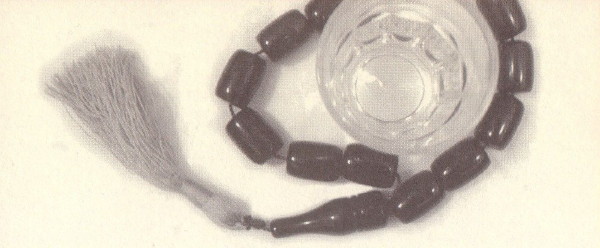
Komboloi
#8, 14
Worry-beads rattled against a drinking glass (see opposite page).
This was characteristic of the music of hash dens, 'tekédes'
i.e. what may reasonably be termed Piraeus rembetica, though it was
also used in some recordings in the Asia Minor style.
Guitar
#1, 2, 4, 5, 7-10, 12-20
The guitar has a fascinating history in Greek popular music. It was
quite certainly played by Greek musicians at the beginning of the last
century. In a recording of a Greek dance tune played on mandolins and
guitar, recorded in Istanbul in 1905, (Instrumental Trio, Vlachiko
Syrto, Victor 63556, 404r, recorded by M.Hampe), the guitar is
heard playing bass notes and chords very much as it might today. During
the period during which the recordings on this CD were made the guitar
was also played in various purely idiomatic Greek fashions both in
Greece and the USA (see tracks 2, 10,13 20). In fact one of the
first responses to the pioneering Halikiás recording of 1932 was
a guitar duet 'cover' by Peristéris, accompanied by Kóstas
Skarvélis, with guitar replacing bouzouki as the solo
instrument. Peristéris appears to have continued using bouzouki
and guitar interchangeably throughout the 1930s. From the 1940s, with
few exceptions, the guitar as a solo voice seems to have disappeared
from the subcultural musical scene, though it continued to be an
important solo instrument in the 'cleaner' light music which eschewed
the bouzouki.
The conventional acoustic wire-strung guitar, played with a plectrum,
or in fingerstyle, has maintained a vital role in Greek popular music
up to the present day. Greek wire-strung guitars are relatively lightly
built with Spanish-style bodies, of different character from the North
American steel-string guitar used by Katsarós. Often the
guitar will be tuned down a whole tone or more; Kostís (see
track 10) Doúsas and Katsaros all used various open
tunings at least some of the time.
Dalgás is to be seen playing a
nine-string guitar with three bass strings on an extension, in a
photograph from around 1930 (see p5). At the time of writing we have no
further reliable knowledge on the origin and use of such guitars in
Greece, although various 'harp guitars' in Western Europe during the
18th & 19th centuries have been extensively described.
The Hawaiian craze, which swept the world during the first decades of
the 1900s, did not leave Greece untouched, and Kostís appears to
have played Hawaiian style tunes on steel guitar, as well as playing
magnificent 'rembetica' in the style heard here.
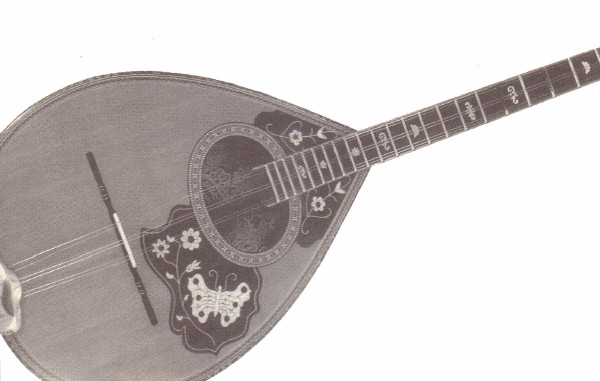
Bouzouki
#1, 3, 4? 5, 7, 8, 14, 16, 18, 21
The bouzouki is a long-necked lute with a wooden soundboard,
carvel-built body and a narrow neck, strung with paired metal strings
and played with a plectrum. Until the mid-fifties it was exclusively a
three-course instrument, i.e. it had three pairs of strings. Its
so-called 'evropïkó' (European) tuning (DAD) was first
standardised during the late 1920s or early 1930s, when ensemble
playing led to the relative abandonment of the handful of
non-transposable tunings called 'douzenia'. The lowest course has
always been an octave pair whereas the other two are unison pairs.
The characteristic tremolo component of mandolin playing seems to have
been imported to the technical arsenal of bouzouki players by the
1930s, especially by Tsitsanis and Chiotis; Vamvakaris
seems to have used tremolo sparingly in his own playing.
Since the mid-fifties, both three- and four-string bouzoukis have
existed side by side, the latter introduced largely on the initiative
of the bouzouki and guitar virtuoso Manólis Chiotis. The
four-string instrument is tuned CFAD with two octave pairs and two
unison pairs. The three-stringed instrument was losing ground until the
'rembetica revival' of the 1970s brought it back into favour with a
younger generation.
The bouzouki has been the subject of much speculation and controversy.
The instrument as we know it today, hitherto perhaps best studied by
the Finnish ethnomusicologist Risto Pekka Pennanen, is perhaps
not much older than the history of sound recording. There is no
consensus on the origin of its name. There is a consensus that a
similar instrument, virtually identical to the instrument known today
as the Turkish saz (Greek 'sazi'), was known earlier on in
Greece as 'tambourás'. But the bouzouki as known since the
beginning of the last century is not much older than just that. It
probably developed simultaneously both in mainland Greece and among
emigré Greeks, and its present-day construction is the result of
a continuous process of development in response to developing needs and
fashions, the first major change being the introduction of the
Neapolitan mandolin-type of body instead of the typically Oriental body
carved out of a single piece of wood. There is, however, evidence that
Turkish saz modified to be playable as bouzoukis were in use in Greece
as late as the 1940's (see Bibliography: Baroúnis).
Furthermore, according to Jack Halikias jr., one of his father's two
surviving bouzoukis maybe of this type.
As in the case of many instruments, use in new contexts created a
demand for greater volume. This spurred luthiers to build higher
tension instruments with different bracing. During the 1950s electric
amplification was also introduced. Fashions of ornamentation have
varied from the simple to the extremely ornate. A point of interest -
some of the earliest surviving bouzoukis which resemble today's
instruments, were built in the first decades of the 1900s in the USA by
the Greek luthier workshop which later changed its name to Epiphone.
The first known recording of a bouzouki, a single side, was made in
Germany in 1917 by Preussische Phonographische Kommission, for
academic purposes. It was never intended for commercial use and is
still, unfortunately, unreleased archive material. The first known
commercial recording including a bouzouki was made in the USA in 1926;
in 1931 the instrument made its recording debut in Greece (see track
3). However, the first truly instrumental solo recording was made
in New York in 1932 (see notes to track 1). Halikias' historic
USA recording may well have triggered the bouzouki's recording career
in Greece; unfortunately, at that time he followed it up with just two
more sides in 1933. As far as we know the bouzouki was then ignored in
American studios from 1933 -1942. the very period of the instrument's
triumphal progress in mainland Greece.
By the 19405 the bouzouki had become the dominant lead instrument in
Greek urban popular music. In the late 1940's Manos Hadjidakis
introduced bouzouki music to the middle classes, followed by Míkis
Theodákis in the late 1950s. From then on the instrument was
enlisted into the nationalist project and the building of the Greek
tourist industry. It was, for example, to be seen decorated with inlays
depicting the Acropolis. The bouzouki was, and still is, to be heard
playing a kind of Greek popular music which Greeks themselves call
'touristiká'. By this is meant music that Greeks assume tourists
wish to hear. To what extent Greeks alone have played an active role
both in creating the genre and the myth of its genuine Greekness is
another question. Parallel with this tourist music however, the
bouzouki continues to play a central role in urban popular music made
by Greeks for Greeks.
There is an instrument played in Lebanon and Syria called 'buzuk' or
'bosuq'. It differs from the Greek bouzouki in only having two pairs of
strings, and in that the frets are arranged according to a quite
different division of the octave than the standard Western chromatic
fretting.
Violin
#4, 11, 19, 20
Already developed to its present-day form in Italy by the 1500s, the
violin has proved itself the most adaptable of all musical instruments,
there being hardly a country in the world which has not adopted it, and
Greece is no exception. The instrument has been a natural member of all
kinds of Greek ensembles, country and urban, subcultural and
mainstream, for at least a century. There were several brilliant
violinists during the period represented by Mortika, for
example the Bulgarian-born Macedonian Slav Nick Doneff (#20), Yiánnis
Dhragátsis aka Ogdhondákis, Dhimítrios
Sémsis aka 'Saloníkios', Aléxis
Zoúmbas, and Athanasíos Makedónias
(#11).
Accordion
#9,17
The accordion was first developed in Vienna in the early 1800s, the
name itself being patented in 1829. Two musicians figure in the early
days of Greek recordings, Yangos Psamatiános and Andónis
Amirális aka Papadzís. Their instrument
sounds drier and has no built-in beat tremolo and is primarily a solo
melodic instrument. Later on, the accordion, as both accompaniment and
melody instrument, was often an integral part of the line-up in
rembetica ensembles from the 1940s onwards.
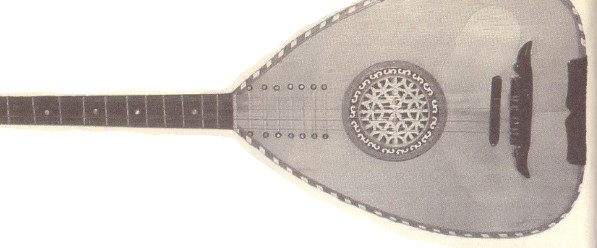
Lauto
#6
The word laoúto, or laghouto, is directly taken from the Italian
word for lute, which in its turn originally came from the Arabic words
'al ud' - the wood. The laouto is a gut- or nylon-fretted four-course
long-necked lute with pared metal strings tuned in fifths. Its
carvel-built body is considerably larger than that of the bouzouki but
it has a shorter neck. It is as it were a hybrid product of the
mandolin and the Oriental oud, a marriage symbolising Italian and
Turkish influence in the area. It is played both melodically and
chordally and has traditionally been an instrument of Crete and the
other Greek islands, and of non-urban mainland Greek folk music.
Lyra
#6
The lyra is a small vertically held bowed instrument of which there are
several known basic types in Greece. In the music on this record we
hear the Cretan version. A lyra indistinguishable from what was called
'kemence' in Turkey was brilliantly, often achingly expressively played
on many recordings of the period by Lámbros Leonarídhis.
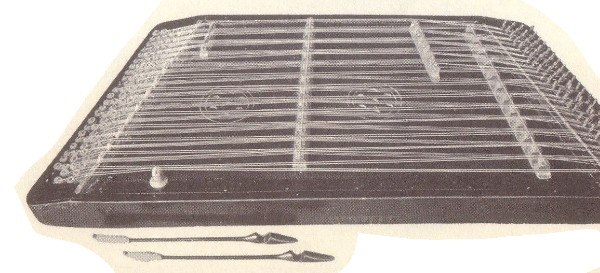
Santour
& Cimbalom
(Greek: tsimbalo) #3, 4, 11, 15
Tsimbalo and santouri are two Greek terms for variants of the type of
instrument known as hammer dulcimer in English, 'cimbalom' in Hungary,
'santur' in Turkey and Iran, 'santir' in Irak and 'santoor' in India.
Current scientific research admits no real evidence that this type of
instrument existed during antiquity. The first convincing depiction is
in a 12th century carved ivory book-cover from Byzantium. Kettlewell,
the instrument's foremost historian, suggests a complex skein of
diffusion routes in Western, Central and Eastern Europe, the Middle
East, and Asia, from about the 12th century onwards, and notes that the
instrument was not mentioned in Middle Eastern sources until the 17th
century, despite certain claims to the contrary.
During the later Ottoman period there was a complex interrelationship
between Armenian, Greek, Gypsy, Jewish, Romanian and Turkish musicians,
all of whom included the dulcimer among the instruments they played.
Information on the history of the instrument in Greece itself is
sparse. The oldest written record of its presence is by the Brit-
ish traveller Edward Daniel Clarke, who heard it in Athens in
1802. It was first mentioned in Smyrna in 1850, as being of western
origin (of the Franks). Cafe songs of Smyrna were often
accompanied by violin and santouri. When refugees from Smyrna and other
parts of Asia Minor came to Greece in the early 1920s, they brought the
instrument with them and it subsequently spread over many parts of the
country. The portable type is called santouri while the stationary type
with damper pedal, originally invented by Vencel József
Schunda (1808-1894) in Budapest in 1874, is called tsimbalo. Stélios
Keromítis (1908 -1979), one of the pioneers of Piraeus
rembetica and exclusively a bouzouki player, said in a radio interview
in the 1970s that the most perfect instrument for his music was the
tsimbalo. The instrument was an integral component of an oft-recorded
line-up consisting of lead singer, tsimbalo, mandola, guitar and violin.
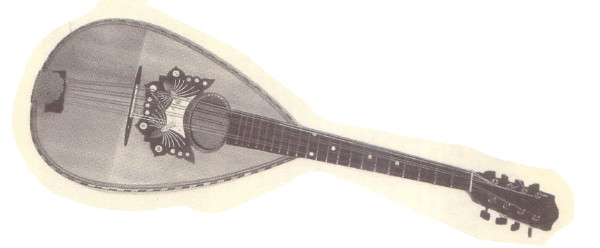
Mandolin
#12
Mandola
# 4? 9, 15, 17, 19
The bowl-backed Neapolitan mandolin in its modern form, with four
unison pairs of metal strings tuned in fifths, was established as such
by the middle or end of the 1800s, though the instrument had first
appeared around 1750.
The Estudiantina ensemble, with mandolins, guitar and markedly
Italianate singing, completely divested of Oriental elements, figures
among other Greek language recordings made in Asia Minor before 1920 (see
the CD 'Smyrni Me Ta Perihora'). The mandolin was also played in
the Athenian 'kantadha' ensembles in their Italianate serenades.
The mandola as used in the music of this period was a larger deeper
Neapolitan-style mandolin made in different sizes. It seems to have
been used exclusively as an ensemble instrument - this writer is not
aware of any true solo recording. In its largest version, the
mandoloncello, it can be heard on some Dalgas sides.
More advanced technical facility on instruments of the mandolin family
in recorded Greek music seems to antedate recorded virtuosity of an
idiomatic kind on the bouzouki by a decade or so. On this CD you may
get some idea of this by comparing the mandolins on track 12 with the
bouzouki on track 3. Admittedly, only three years separate these
particular recordings, but the 1905 Constantinople mandolin recording
mentioned above demonstrates at least the same technical level as that
heard on track 12. A comparable technical level on the bouzouki is not
to be heard on disc until 1932. An important reservation must be made
here. We are talking of recorded music; because they were not welcome
in studios, that does not mean there were no accomplished bouzouki
players earlier on. If musicians like Vamvakáris and
Keromítis could talk with reverence about a Manétas -
then what do we know? Even if many stories of persecution and
stigmatisation of bouzoukis and their masters are patently exaggerated,
there are fragments of genuine evidence that the bouzouki was, in one
way or another, 'persona non grata' for a long time.
When talking of pure virtuosity on the mandolin, it must be said that
some of the recorded Italians of the period far outstrip any of their
Greek colleagues. Comparable virtuosity on the bouzouki was first to be
recorded later in the 1930s with the playing of Vassílis
Tsitsánis - who in fact started on mandola - and Manólis
Hiótis, the latter still in his teens at his debut. Players
of the mandolin and mandola do not seem to have received the same kind
of attention and formal recognition as players of other 'default'
instruments of this period, and have, with the exceptions of Peristéris,
Toúntas and Dávos in Greece, and Ierothéos
Schízas in the USA, apparently remained nameless.
Notwithstanding, the mandolin and mandola are to be heard on a fair
number of recordings, notably those of Dalgás, Ríta
Abadzí, Róza Eskenázi and Stellákis
Perpiniádhis, and the mandola is also to be heard doubling the
melody on some of Papadzís' instrumental accordion tracks. The
presence of the mandola has been consistently underestimated in
otherwise perceptive annotations to reissues of this music. The sound
and balance of an ensemble on record is of course the result of choices
made by producers and recording engineers, even when using single
microphone technique. The mandola is often in the background and is
sometimes so discreetly placed that one might both wonder if it was at
all audible with the conventional sound reproduction of that time, and
whether it was always meant to be heard! There are recordings where the
mandola only plays behind the vocalist, doubling the melody line almost
as a guide or prompter. Occasionally it plays the foreground
introductory phrases later assigned to the bouzouki. One possible
reason for the paucity of credits for mandolin and mandola players in
recording company files might, in the light of these observations, be
that the studio director and musician are in certain cases one and the
same person, who doesn't see the need to be mentioned as he is already
being paid to direct the recording.
It is worth mentioning that Stellákis Perpiniádhis, when
selecting his favourite recordings for the LP reissue 'Autoviographia'
during the 'rembetica revival' of the 1970s, chose recordings featuring
mandolin, mandola, guitar, violin, accordion and santoúri, and
the unique instruments played by Iován Tsaoús, but chose
no true bouzouki. loánnis Papaioánnou - a famous
singer-bouzouki player-songwriter not represented here - gave mandola
as his metier on an official document, though we only have recordings
of him playing bouzouki. What we don't know is whether
Papaioánnou mentioned the mandola because the bouzouki was not comme
it faut in official situations. Furthermore, some early bouzoukis
of the period had a mandola body construction with the characteristic
shallow convex angle in the sound-board just behind the bridge. This
characteristic later disappeared from bouzouki construction.